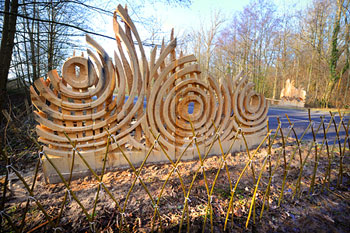The flames also represent East Hoathly's vibrancy and vivacity as a community.
The theme of oak has been continued in a steel frieze in the shape of oak leaves to represent the abundance of ancient oak woodland in the parish. Intertwining with these leaves are feathers to represent the quill pen of the famous Georgian diarist and village trader Thomas Turner.
Planted behind the frieze is a woven willow hedge which represents the willow used to make Sussex trugs at Rich's Trug Makers, an agricultural carpentry business operational in East Hoathly until the 1970s.
The hedge will mature to provide a vibrant green backdrop to the oak lattice, and has been woven to achieve a 'laid hedge' effect to further echo the village's agricultural heritage.
Heather has been planted around the living sculpture, linking the village with the plant from which it takes its name. 'Hoathly' comes from the Old English 'hathel' and 'leah', meaning 'heathery wood clearing'.









